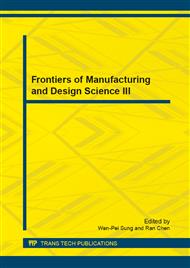[1]
Virgilio Quintana,Louis Rivest,Robert Pellerin,Frederick Venne,Fawzi Kheddouci. Will Model-based Definition replace engineering drawings throughout the product lifecycle? A global perspective from aerospace industry[J]. Computers in Industry,2010,61(5): 497-508.
DOI: 10.1016/j.compind.2010.01.005
Google Scholar
[2]
Y.S. Kim,E.Wang. Recognition of machining features for cast the machined parts[J]. Computer-Aided Design,2002,34(1):71-87.
DOI: 10.1016/s0010-4485(01)00058-6
Google Scholar
[3]
Wan Neng, Zhao jie, Mo Rong. Three dimensional machining process model creation methods[J]. Computer Integrated Manufacturing Systems,2011,17(10):2112-2118 [4] Bojan Babic,Nenad Nesic,Zoran Miljkovic. A review of automated feature recognition with rule-based pattern recognition[J]. Computers in Industry,2008,59(4):321-337.
DOI: 10.1016/j.compind.2007.09.001
Google Scholar
[5]
S.B. Kailash Y.F. Zhang J.Y.H. Fuh. A volume decomposition approach to machining feature extraction of casting and forging components[J]. Computer-Aided Design, 2001, 33 (8):605-617.
DOI: 10.1016/s0010-4485(00)00107-x
Google Scholar
[6]
W.D.Li,S.K. Ong A.Y.C. Nee. Recognizing manufacturing features from a design-by-feature model[J]. Computer-Aided Design,2002,34(11):849-868.
DOI: 10.1016/s0010-4485(01)00156-7
Google Scholar
[7]
Mohammad T,Hayasi,Bahram Asiabanpour. Extraction of manufacturing information from design-by-feature solid model through feature recognition[J]. Advanced Manufacturing Technology,2009,44(11-12):1191-1203.
DOI: 10.1007/s00170-008-1922-6
Google Scholar
[8]
Shusheng Zhang,Yunfei Shi,Haitao Fan,et al. Serial 3D model reconstruction for machining evolution of rotational parts by merging semantic and graphic process planning information[J],Computer-Aided Design,2010,42(9):781-794.
DOI: 10.1016/j.cad.2010.04.007
Google Scholar
[9]
Wang Fei,Zhang Shusheng, Bai Xiaoliang. Local matching of 3D CAD models based on subgraph isomorphism[J]. Journal of Computer-Aided Design & Computer Graphics,2008, 20(8):1078-1084
Google Scholar
[10]
F.Zhou, T.C. Kuo, S.H. Huang, H.C. Zhang. Form Feature and Tolerance Transfer from a 3D Model to a Set-up Planning System[J]. Advanced Manufacturing Technology,2002,19(2): 88-96.
DOI: 10.1007/s001700200001
Google Scholar
[11]
Jian Gao, De Tao Zheng, Nabil Gindy, Doug Clark. Extraction/conversion of geometric dimensions and tolerances for machining features[J]. Advanced Manufacturing Technology, 2005,26(4):405-414.
DOI: 10.1007/s00170-004-2195-3
Google Scholar


